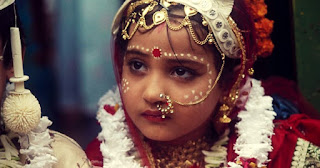THE EYESORE...BUT WHY??
At the very beginning, I want to state that this piece is not directed to any particular community or group, nor it is meant to offend anyone. It is just an amalgamation of different experiences and observations that I had made over the years.
The legal age of marriage in
India was 18 years, which has been recently raised to 21 years. But in India,
we had a heinous practice of “Child Marriage” in the past – something which is
still practiced in many remote areas of the country. If we ask our grandmothers
to recount their tales of marriage, a lot of them would say that they had got
married at the age of 6 or 7 years – even before attaining puberty! And after
that, they had raised 8-10 children while living in giant families. But has it
ever crossed our minds why were girls married so early to men thrice their age?
The answer is simple – girls are always considered a “burden” or if put in
hindi, they are considered “bhojh”.
It is not the concept of raising girls which was difficult but rather the
thought of getting the girl married that bothered a household because of the
prevalence of ‘dowry’. However, with the changing times, technological
advancement, government initiatives and numerous efforts, the dowry system has
been abolished to a large extent, if not completely. There are still
communities where huge amount of money, in cash and kind, is given by a girl’s
family for marriage if she has some form of physical anomaly.
But is it only ‘dowry’ that
bothers a girl’s family when she reaches a marriageable age? Why is it that
even parents of girls in urban India, where dowry is nearly negligible, remain
worried for their daughters? This again goes to the concept of considering
girls as “parayadhan.” No matter how
good-looking, well-educated, self-sustaining a girl or a woman is, she isn’t
considered a “well-settled” human being in life if she is unmarried or has no children.
Even our ace tennis star, Sania Mirza after few years of marriage with Shoaib
Malik, was asked when was she planning to “settle in life” as she didn’t have
children then. This kind of mentality actually revolves around the age-old
realms of patriarchy that is very deeply ingrained in the Indian society. There
is a belief that a girl is always the responsibility of first her father, then
brother, and finally her husband. Irrespective of the fact that we have
examples of Kiran Mazumdar Shaw, Indra Nooyi, Manju Sharma and others in our
society, irrespective of the fact that a girl has the prefix of “Dr./Prof.”
despite being a “Ms.”, she isn’t a perfect girl if she isn’t a “Mrs.” Maa-baap ke baad aakhir bechari ladki ko
dekhega kaun? Khud kamati hai to
kya..! An independent, well-to-do, unmarried girl is always a societal
eyesore; parents also tend to freak out on the ever-lasting Indian question of
“Log kya kahenge?” Even after
marriage, a girl cannot be the bread-earner of an Indian family nor can a boy
be “stay-at-home-dad” – a concept which isn’t very alien in the western culture
and which was very beautifully portrayed in Anne Hathway’s “The Intern.”
My article isn’t
“Anti-marriage” or “Anti-Parenting” for girls. It simply wants to highlight the fact that our society needs to be a little more progressive when it comes to
women and marriage. It isn’t very easy to change this deep-rooted mindset of
people with just an article or talk but at least we can try to make a
head-start in that direction.




Comments
Post a Comment